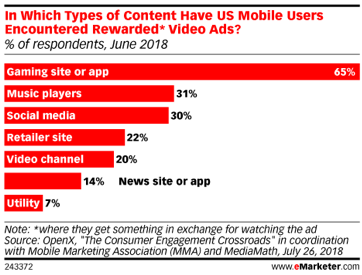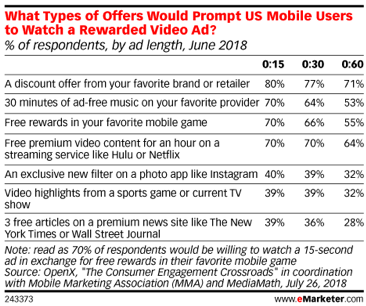This post was created with help from Jess Anguiano.
NEWS & TRENDS
Mobile Video Advertising in 2019
- One study found that by 2020 more money will be spent on mobile ads than on all traditional media ad spending combined. As mobile becomes increasingly popular, mobile ad spend and ad approaches are responding to the preferences of mobile users.
- Popular formats and resulting trends:
- A rise in rewarded video, also known as value exchange ads, where users elect to watch the video ad in exchange for some form of reward. Unlike traditional digital ads, rewarded video ads are viewed according to the preference of users. Further, because viewers opt into watching the ads, rewarded video ads have a completion rate of more than 90%. While rewarded video ads are typically seen in gaming apps, companies are finding ways to use them in non-gaming apps.
- Non-skippable ads are very unpopular amongst viewers, while skippable ads are the favorite amongst mobile ad formats.
- 6 second videos are heavily favored by younger generations.
- Vertical video has made its mark in social but is slowly penetrating other platforms.
- Why does this matter? As viewers continue to move towards mobile, marketers are continuously monitoring metrics to determine which ads are most effective. The formats discussed are receiving positive reactions and conversions from users. In particular, advertisers should embrace the value exchange video ad model and tailor the reward to their business. Rewarded video ads are an impactful format that should be incorporated into a successful marketing strategy.


Google’s Rich Results Test Allows Code Editing
- Google’s Rich Results Test now allows you to test all code edits live. An individual can run code data, and then subsequently update the code to run again and see how the edits impact their results This feature allows individuals to proactively manage their rich results.
- Rich results make it easier for search engines to crawl a site and understand the contents of a page. Rich results are proven to have increased clickthrough rates and decreased bounce rates.
- Why does this matter? This feature will allow developers to ensure that their rich snippets are appropriately coded, and further, explore rich snippet opportunities.
YouTube Will Stop Showing Existing Annotations
- Recognizing the trend towards mobile and focusing on user experience, YouTube announced that it has stopped showing annotations to viewers as of January 15, 2019.
- YouTube is shifting their focus to the mobile experience and encouraging companies to use end screens and cards instead.
- “With 60% of YouTube’s watch time now on mobile, why go through the work of creating annotation that won’t even reach the majority of your audience? End screens and cards work on mobile and desktop.”







Responses